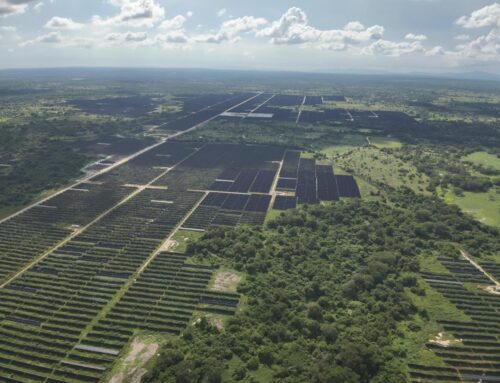How solar energy is starting to pay off for Minnesota schools
May 29, 2025
Ken Gagner is no meteorologist, but he knows to forecast extra cost savings for his school district on sunny days.
The superintendent got one of those days before Braham Area Schools’ graduation ceremony last week. On the roof above Gagner’s office, solar panels soaked up the sun’s rays, generating electricity measured in kilowatt-hours (kWh). One keystroke on Gagner’s computer gave him real-time updates, a valuable tool for teaching students about renewable energy. “That’s really the neat part about this is there is an education component,” he said. “Obviously we’re saving taxpayer dollars, but the kids are learning about this energy source that is going to get better and better.”
Braham, in Isanti County, is among more than 140 schools to install solar arrays as part of Minnesota’s Solar for Schools grant program since it launched in 2022. In a time of budget crunches for schools around the state, any savings derived from the program are welcome. In some cases, boosted by state and federal incentives, districts are already coming out ahead on savings compared to costs.
It took less than two years for Braham to reach that point, Gagner said. Solar arrays on high school and elementary school buildings cost $228,830 in total. State grants totaling $194,505 and $30,571 in federal funding covered all but $3,754 of it. Gagner’s rough estimate of the district’s net savings between August 2023 and March 2025 is around $7,200. “We’re already in the positive,” he said.
Each year, the Minnesota Department of Commerce submits a legislative report detailing Solar for Schools program updates. It lists new grant awards, how much electricity is being generated and the impact on school expenses.
Braham’s 90 kilowatt direct current (kWdc) system size is projected to save it more than $215,000 in electrical costs during a 25-year lifespan, according to the report. Bigger array systems, like International Falls High School’s 411 kWdc, have lifetime cost savings estimates in the $12.8 million range.
Collectively, the report states Minnesota schools participating in the program saved about $1.4 million total in year one. Their cumulative lifetime savings are estimated to be around $61 million.
Schools were interested in solar projects before the state program launched, said Peter Lindstrom of Clean Energy Resources Teams (CERTs), but the grants jump-started the interest. “This program put the pedal to the metal for schools installing solar,” he said. “No question about that.”
CERTs provides technical assistance to schools, farms, churches and other entities interested in solar energy. Energy is among the highest expenses for schools, Lindstrom said, making any savings through solar appealing. “It’s really the only place that a school can make cuts, with the help of renewable energy, and not make an impact on the classroom,” Lindstrom said.

Factoring in the array’s education, environmental and cost saving benefits, Gagner said the program is a no-brainer for Braham. He acknowledged that state and federal funding isn’t free — ultimately it comes from tax dollars — but said the solar savings equate to a net positive for taxpayers in his school district. Those savings could amount to tangible benefits during budget crunches. “Let’s say we save 10 grand a year, well that goes to a para [paraprofessional] we could hire,” he said. “What would’ve been an electrical bill, now I can put that money elsewhere.”
Caledonia Public Schools, located in Houston County, added solar arrays to its middle/high school and elementary school buildings in July 2024. The district received $203,575 in state grant funding through the Solar for Schools program. This covers the bulk of the system cost, while Superintendent Craig Ihrke said the district is waiting on federal funding to cover the remainder. “If that comes through, and being that it’s federal dollars I don’t know that we’re for sure getting it, basically those two arrays would’ve been installed for free,” he said.
The Inflation Reduction Act of 2022 made schools eligible for tax credits to build clean energy projects through direct pay, or elective pay, provisions. The Republican-controlled Congress hasn’t repealed the act, but has put certain climate provisions in its crosshairs.
Related: Trump budget bill would gut solar, other clean energy investments that have brought Minnesota $1 billion
Elective pay has been instrumental in helping schools pursue solar projects, Lindstrom said. “Any public policy that puts back barriers would be a significant challenge,” he said.
Minnesota lawmakers have also set their sights on funds fueling the Solar for Schools program. A bill sponsored by Rep. Chris Swedzinski, R-Ghent, in March would’ve eliminated the Renewable Development Account, a state fund used for a range of renewable energy projects. Xcel Energy pays about $30 million annually into the fund, a requirement stemming from a nuclear waste storage facility it was allowed to build next to its Prairie Island nuclear generating plant.
Even if federal funds never materialize, Caledonia is estimated to save about $10,000 per year through its solar electricity generation. The legislative report puts its lifetime savings at around $330,000. Caledonia installed its arrays on the ground rather than the roof because of the age of the district’s buildings. In time, if the roofs get replaced, Ihrke said it’s possible the district could look into adding more solar panels through the program.
As in Braham, the savings in Caledonia may end up making budget considerations easier, Ihrke said. “What it’s doing now with the status of everyone’s budget, it’s reducing the need for reducing positions,” he said.
Search
RECENT PRESS RELEASES
Related Post



